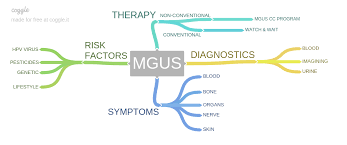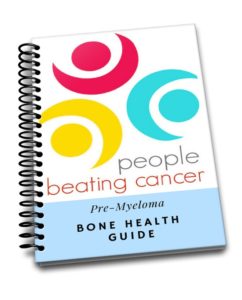
Diagnosed with SMM, SPB, or MGUS?
Learn how you can stall the development of full-blown Multiple Myeloma with evidence-based nutritional and supplementation therapies.
Click the orange button to the right to learn more.
- You are here:
- Home »
- Blog »
- Pre-Myeloma »
- MGUS, Bone, Scan…
MGUS, Bone, Scan…

“Early identification of MGUS and evaluation of bone status will facilitate prophylactic treatment with bisphosphonates to increase bone density and likely reduce the risk of fractures”
I agree with Dr. James Berenson when he says that early I.D. of MGUS and evaluation of bone health is important. I agree as much as I can agree with a conventional MM specialist. Dr. Berenson talks about bisphosphonate therapy and I talk about evidence-based but non-toxic bone health therapies.
Further, the second article linked below talks about whole-body MRI being more sensitive when it comes to examining bone health. The idea is to examine your bone density aka your bone density in order to prevent a fracture.
MGUS increases the risk of a bone fracture. My point is to build bone health before your bone fractures.
I included both studies to give pre-MM patents a sort of one-two punch for keeping their bones health- timing and methods.
If the MGUS or SMM patient determines that their bones need strengthening, I am fine with a little bisphophonate therapy (Zometa, Aredia, etc.) but I want to include frequent, moderate exercise, evidence-based, non-toxic supplementation such as curcumin.
To Learn More about Monoclonal Gammopathy of Undetermined Significance (MGUS)- click now
If you have any questions about pre-MM in general or your bone health specifically, scroll down the page, post a question or comment and I will reply to you ASAP.
Thank you,
David Emerson
- MM Survivor
- MM Cancer Coach
- Director PeopleBeatingCancer
Recommended Reading:
- Wait for Pre-Myeloma to Progress or Try Non-Conventional Therapies?
- MGUS Diagnosis In Over 50- Over 5%!
- MGUS- Evidence-Based, Non-Toxic Therapies
- SMM, MGUS, Fibromyalgia, Nerve Pain?
- Osteoporosis in Men – MGUS, SMM, Pre-Myeloma?
“Monoclonal gammopathy of undetermined significance (MGUS) is a plasma cell disorder characterized by the presence of a serum monoclonal immunoglobulin (M-protein) at <or= 3 g/dL. It is an asymptomatic premalignant disorder that can progress to multiple myeloma and related B-cell disorders.
Recent studies have suggested the association of MGUS with enhanced bone loss and debilitating skeletal complications, particularly vertebral compression fractures (VCFs) often leading to back pain.
Early identification of MGUS and evaluation of bone status will facilitate prophylactic treatment with bisphosphonates to increase bone density and likely reduce the risk of fractures as well as identify patients with VCFs who might benefit from early surgical intervention.
With proper diagnostic and treatment strategies, these patients will experience improved outcomes and quality of life.”
Comparison of the diagnostic performance and impact on management of 18F-FDG PET/CT and whole-body MRI in multiple myeloma
“This study compared the diagnostic performance and impact on management of 18F-fluorodeoxyglucose positron emission tomography/computed tomography (18F-FDG PET/CT) and whole-body magnetic resonance imaging (WBMRI) in treatment-naive myeloma…
Blinded clinical and imaging data were reviewed by two haematologists in consensus and management recorded following clinical data ± 18F-FDG PET/CT or WBMRI. Bone disease was defined using International Myeloma Working Group (IMWG) criteria and a clinical reference standard. Per-patient sensitivity for lesion detection was established. McNemar test compared management based on clinical assessment ± 18F-FDG PET/CT or WBMRI…
Results-
Sensitivity for bone lesions was 69.6% (32/46) for 18F-FDG PET/CT (54.3% (25/46) for PET component alone) and 91.3% (42/46) for WBMRI. 27/46 (58.7%) of cases were concordant.
In 19/46 patients (41.3%) WBMRI detected more focal bone lesions than 18F-FDG PET/CT. Based on clinical data alone, 32/46 (69.6%) patients would have been treated. Addition of 18F-FDG PET/CT to clinical data increased this to 40/46 (87.0%) patients (p = 0.02); and WBMRI to clinical data to 43/46 (93.5%) patients (p = 0.002).
The difference in treatment decisions was not statistically significant between 18F-FDG PET/CT and WBMRI (p = 0.08)…
Conclusion
Compared to 18F-FDG PET/CT, WBMRI had a higher per patient sensitivity for bone disease.
However, treatment decisions were not statistically different and either modality would be appropriate in initial staging, depending on local availability and expertise…
A small number of studies, with limited sample sizes, have compared the diagnostic accuracy of 18F-FDG PET/CT and WBMRI in myeloma [2,3,4,5], but to date, there has been a lack of comparative data of the impact on management of 18F-FDG PET/CT and WBMRI.
Both techniques have advantages. While WBMRI has superior sensitivity for diffuse bone marrow infiltration [6], 18F-FDG PET/CT better demonstrates lesion viability following treatment [7];
both convey prognostic information [8, 9].
Additionally, in patients with smouldering myeloma, the presence of >1 focal bone lesion detected by WBMRI [10] or the presence of a focal FDG-avid lesion [11] is a strong prognostic factor for progression to myeloma such that they are now recognised as an indication to treat otherwise asymptomatic myeloma [12, 13]…
…We hypothesised that the greater sensitivity of WBMRI for detection of myeloma compared to 18F-FDG PET/CT would alter patient management in a greater proportion of cases. Thus, the primary aim of this study was to compare the diagnostic performance of 18F-FDG PET/CT and WBMRI for bone disease in patients with a new myeloma diagnosis and to assess whether management differed depending on which imaging was performed initially…
18F-FDG PET/CT
There was moderate agreement between the two readers in scoring for the presence/absence of focal CT and PET disease, with a kappa score of 0.44 and 0.47, respectively. Identification of CT disease was discordant in 3/12 patients, where CT positive but FDG-negative lesions were noted by one reader. Identification of FDG-positive disease was also discordant in 3/12 patients.
Whole-body MRI
There was excellent agreement between the two readers in scoring for the presence/absence of focal lesions on a per patient basis (kappa score, 1.00). With respect to the scoring of the number of lesions across the 7 regions, mean ± SD focal lesion score was 7.4 ± 5.7 for Reader 1 and 7.7 ± 5.5 for Reader 2; with an intraclass correlation coefficient of 0.95 [95%CI: 0.84-0.99].
With respect to the presence/absence of bone marrow infiltration, there was good agreement between both readers with a kappa score of 0.74; one patient with a bone marrow infiltration percentage of 90% on biopsy was assigned incorrectly as negative by one reader…
Impact on clinical management
Based on the review of clinical data alone, 32/46 (69.6%) of patients would be treated for myeloma rather than active surveillance, in accordance with institutional treatment protocols. Review of clinical data with 18F-FDG PET/CT resulted in treatment of 40/46 (87.0%) patients, and review of clinical data with WBMRI resulted in treatment of 43/46 (93.5%) patients…
Discussion
Our study confirms that WBMRI detects skeletal disease in a higher number of treatment-naïve patients than 18F-FDG PET/CT and also detects a higher number of lesions per patient with concordance in disease positivity/lesion number in only 59% of patients…


